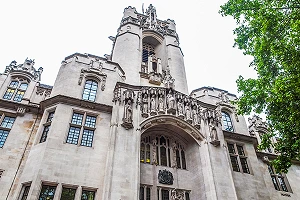
Litigation as stewardship: How UK pension funds including LGPS are shaping corporate accountability
Revisiting Cheshire West
Wardship and Inherent Jurisdiction: Decisions involving competent 17-year-olds
Public children law case update – Autumn 2025
Post-placement contact under the Adoption and Children Act 2002

Compulsory purchase compensation reforms: the next stage
Climate legal risk and property: what local authorities need to know
The £5bn Pride in Place programme – what does it mean for local authorities?
How not to control second homes
Twelve New Towns for the Future

Authority to participate in legal proceedings and rights of audience
Artificial intelligence in Education and EHC Plans
Just what is it about today’s planning system that makes appealing so … appealing?
High Court on highway widths
Risk assessment – a safeguard to fairness
Appealing the outcome of a fact-finding hearing in care proceedings
Parental obstruction of care
School exclusions – CCTV and police investigations?
Transparency in the Court of Protection
Break Stuff – The decision in On Tower UK Ltd v British Telecommunications plc [2025] and the impact in respect of break rights in Code Agreements
Tackling youth ASB in social housing
Understanding part-heard hearings in civil litigation
How AI could rewrite homelessness law
Social and affordable housing as a driver of economic growth
Suitability of accommodation offered in performance of the prevention duty
Key updates to the Administrative Court Guide
A gem of a case on section 106 mortgagee exclusion clauses?
Why are so many schools and colleges suspending pupils?
PFI expiry and handback
Payment requirements under the Procurement Act 2023
Civil protective orders and gangs
"Build baby build" – How MHCLG will change now Steve Reed is Secretary of State
Dual-hatted members and local government reorganisation
Hillsborough Law: What local authorities need to know
School admissions: A guide to parental rights
A hard road
Gypsy/Traveller caravan sites and supply of pitches
Environmental enforcement powers: Walker v Chelmsford City Council [2020] EWHC 635 revisited
Infrastructure project ‘fast-track’ process ‘re-design’ proposed
Below-threshold contracts
A different kind of target
DOLS and the Young Offender: Care or Custody?
Brief enquiry of age
Fact-finding in care proceedings: lessons from G (A Child)
School trips: key legal considerations
Six months in, six key differences: How the Procurement Act measures up to the Green Paper
Nicola Cullen considers how the Procurement Act 2023 compared to the original Green Paper and assesses the impact so far of the legislation.
- Details
Back in December 2020, the UK Government published its Green Paper: Transforming Public Procurement, promising a simpler, more transparent and more flexible regime to replace the EU-derived Public Contract Regulations 2015 (PCR). Fast forward to 24 February 2025, and the Procurement Act 2023 (the Act) came into force.
With six months of the Act now behind us, it’s a good moment to reflect on how far it delivers on the ambitions of the Green Paper, and where the vision has shifted. In this article, we have identified six key differences between the Green Paper’s vision and the Act’s reality.
1. Cap of damages – dropped
The Green Paper proposed capping damages in procurement claims to discourage speculative litigation. Ultimately, this idea was rejected. Courts retain discretion, recognising that inflated awards are rare and that existing principles already set a high bar for recovery.
For SMEs in particular, this is a welcome outcome as legitimate challenges remain worth pursuing, and the risk of being under compensated has been avoided.
2. Lifting the automatic suspension – no new test
The Green Paper proposed moving away from the American Cyanamid test, which some considered ill-suited to public procurement disputes. While the Act sets out a ‘new’ statutory test for automatic suspensions, in practice there are only slight tweaks in wording.
Automatic suspensions will likely continue to frequently be lifted in favour of public service continuity. While some hoped for a bespoke procurement test, judicial flexibility and certainty ultimately prevailed.
3. Light touch regime – retained
The Green Paper suggested scrapping the light touch regime, expecting the new ‘competitive flexible procedure’ to cover the commissioning of health, social care and other services.
Ultimately, the Act retained a simplified light touch regime with higher thresholds. This was a pragmatic adjustment, recognising the distinct challenges of person-centred services where flexibility and proportionality matter most.
4. Procurement tribunal – abandoned
One of the boldest proposals was a specialist tribunal for procurement disputes, making the prospect of challenges faster, cheaper and more accessible for SMEs than the courts.
The Act abandoned this idea, keeping the familiar court-based system. While this avoids the cost and complexity of establishing a new forum, it leaves the question open of whether smaller suppliers truly have better access to justice under the new regime.
5. Limited tendering – disappeared
The Green Paper envisaged three procedures: open, competitive flexible and limited tendering (for exceptional cases such as urgency).
The Act takes a different approach. Limited tendering does not feature as a defined procedure. Instead, contracting authorities may use direct award routes under tightly drawn statutory grounds. This gives the Act a sense of familiarity compared to the Green Paper by continuing with existing terminology.
6. Disclosure of tenders – not implemented
Perhaps the most radical transparency proposal in the Green Paper was for contracting authorities to publish evaluation documents and even bidders’ tenders (with redactions).
The Act significantly expands notice and reporting requirements but stops short of mandating disclosure of full tenders. This avoids heavy administrative burdens and confidentiality risks, while still moving the dial on transparency.
Final thoughts
The Green Paper promised revolution. The Act delivers evolution.
Six months in, the regime feels more familiar than feared. Most practitioners have been able to continue ‘business as usual’, albeit with some important enhancements around transparency, notices and flexibility.
Familiarity is not necessarily a bad thing. Radical reform could have created real disruption, whereas the Act has achieved change in a way that feels steady and manageable. With further regulations and consultations (including the Growing British industry, jobs and skills consultation) already underway, this is clearly intended as a living system, one that can adapt as procurement practice continues to evolve.
The next six months will show whether that adaptability will strengthen, or whether the more ambitious ideas left behind in the Green Paper will eventually need to be revisited.
Nicola Cullen is an Associate at Capital Law.
Senior Lawyer - Contracts & Commercial
Lawyer - Property
Trust Solicitor (Public & Healthcare Law)
Trust Solicitor (Employment & Contract Law)
Contracts & Procurement Lawyer
Locums
 Institutional landlord series: Possession – High Court Enforcement - 5 Pump Court
Institutional landlord series: Possession – High Court Enforcement - 5 Pump Court
22-10-2025 4:00 pm
Online (live)
 Institutional landlord series: Costs Recovery and Legally Aided Parties - 5 Pump Court
Institutional landlord series: Costs Recovery and Legally Aided Parties - 5 Pump Court
05-11-2025 4:00 pm
Online (live)
 HMPL Building Blocks: Tenancy Management – Assignment, Mutual Exchange and Succession - Devonshires
HMPL Building Blocks: Tenancy Management – Assignment, Mutual Exchange and Succession - Devonshires
12-03-2026
Online (live)
 Unpicking the Procurement Act Episode 2: Exclusion and Debarment - 39 Essex Chambers
Unpicking the Procurement Act Episode 2: Exclusion and Debarment - 39 Essex Chambers
On Demand
Online (pre-recorded)
 Unpicking the Procurement Act Episode 1: Overview and New Procedures - 39 Essex Chambers
Unpicking the Procurement Act Episode 1: Overview and New Procedures - 39 Essex Chambers
On Demand
Online (pre-recorded)
 Unpicking the Procurement Act Episode 3: Contract Modification - 39 Essex Chambers
Unpicking the Procurement Act Episode 3: Contract Modification - 39 Essex Chambers
On Demand
Online (pre-recorded)
 Unpicking the Procurement Act Episode 4: Challenges and Remedies - 39 Essex Chambers
Unpicking the Procurement Act Episode 4: Challenges and Remedies - 39 Essex Chambers
On Demand
Online (pre-recorded)



























































































 CUBAS Comprehensive Training & Licencing (Swindon), October 2025
CUBAS Comprehensive Training & Licencing (Swindon), October 2025  Property Law Roadshow 2025 - Cardiff - St John's Chambers
Property Law Roadshow 2025 - Cardiff - St John's Chambers  Planning Day 2025 - Cornerstone Barristers
Planning Day 2025 - Cornerstone Barristers  Annual Fraud Conference 2025 - Oxford Investigation Service
Annual Fraud Conference 2025 - Oxford Investigation Service  Ivy Legal - Certificate in Planning Enforcement
Ivy Legal - Certificate in Planning Enforcement